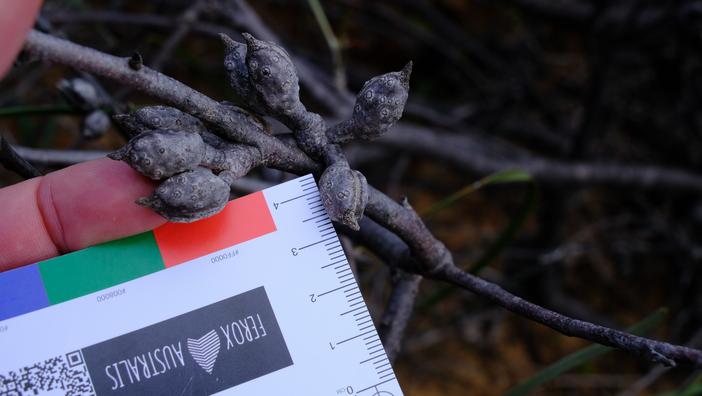Needle-Leaved Hakea
(Hakea pycnoneura)
Needle-Leaved Hakea (Hakea pycnoneura)
/
/

Peter Crowcroft
CC BY 4.0
Image By:
Peter Crowcroft
Recorded By:
Copyright:
CC BY 4.0
Copyright Notice:
Photo by: Peter Crowcroft | License Type: CC BY 4.0 | License URL: http://creativecommons.org/licenses/by/4.0/ | Occurence ID: https://www.gbif.org/occurrence/4528214670 | Publisher: Inaturalist |

























Estimated Native Range
Summary
Hakea pycnoneura, commonly known as the Needle-leaved Hakea, is an evergreen shrub endemic to the sandplains and coastal heathlands of Southwest Western Australia. It typically grows to a height of 2 to 3 meters (7 to 10 ft) and has a rounded, fairly open habit with smooth grey bark. The plant is notable for its clusters of cream-pink flowers with a purple base, which bloom from May to August and are found in the leaf axils or on old wood. These flowers are moderately showy and attract nectar-feeding birds. The foliage consists of flat, thick, linear leaves that are 9–20 cm (4–8 in) long, sometimes curving and ending in a sharp point with a prominent midvein. The corky ovoid fruit, which are 15–25 mm (0.6–1 in) long and 8–12 mm (0.3–0.5 in) wide, feature small spikes on the surface and add textural interest to the plant.
Needle-leaved Hakea is valued for its ornamental qualities, including its unique foliage and frost tolerance. It is well-suited for use in water-wise gardens, rockeries, and as a feature plant in Mediterranean-style landscapes. This species thrives in full sun and requires well-drained soils, preferably sandy, with low water needs once established. It is relatively low-maintenance but can be susceptible to root rot if overwatered or planted in poorly drained soils. There are no widely known cultivars of this species, and it is not typically associated with aggressive roots or significant disease problems. However, gardeners should be cautious of its sharp leaves when planting in areas with pedestrian traffic.CC BY-SA 4.0
Needle-leaved Hakea is valued for its ornamental qualities, including its unique foliage and frost tolerance. It is well-suited for use in water-wise gardens, rockeries, and as a feature plant in Mediterranean-style landscapes. This species thrives in full sun and requires well-drained soils, preferably sandy, with low water needs once established. It is relatively low-maintenance but can be susceptible to root rot if overwatered or planted in poorly drained soils. There are no widely known cultivars of this species, and it is not typically associated with aggressive roots or significant disease problems. However, gardeners should be cautious of its sharp leaves when planting in areas with pedestrian traffic.CC BY-SA 4.0
Plant Description
- Plant Type: Shrub
- Height: 4-6 feet
- Width: 4-6 feet
- Growth Rate: Moderate
- Flower Color: Cream, Pink, Purple
- Flowering Season: Fall, Winter
- Leaf Retention: Evergreen
Growth Requirements
- Sun: Full Sun
- Water: Low
- Drainage: Medium, Fast
Common Uses
Bird Garden, Butterfly Garden, Low Maintenance
Natural Habitat
Endemic to the sandplains and coastal heathlands of Southwest Western Australia
Other Names
Common Names:
Scientific Names: , Hakea pycnoneura,
GBIF Accepted Name: Hakea pycnoneura Meisn.